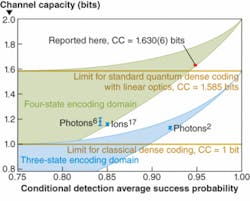QUANTUM INFORMATION: Hyperentanglement beats photon-communications limit
Quantum dense coding allows a sender of digital information (Bob) to communicate a maximum of two bits of classical information to a receiver (Alice) by transmitting only a single quantum bit—if Alice and Bob share a pair of photons that are quantum-mechanically “entangled.” Bob can encode one of four messages in the joint quantum state of the photons by modifying just the polarization of his half.
Unfortunately, using standard optical components, Alice can only distinguish three of four states, reducing the attainable channel capacity (CC) from two bits (log2 4) to 1.58 bits (log2 3). And until now, even that reduced value was not realized in practice: the best previous result was 1.18 bits. But by using pairs of photons “hyperentangled” in an extra degree of freedom (orbital angular momentum, OAM, in addition to polarization), researchers at the University of Illinois at Urbana-Champaign have deterministically discriminated all four entangled states, in a dense-coding method that breaks the conventional threshold and achieves a maximum CC of 1.63 bits.1
Hyperentanglement is realized in pairs of photons entangled in both their polarization and OAM, and measured using special interferometers. The first beamsplitter in each interferometer is a holographic grating that transforms an incoming photon in a particular OAM state into a zero-OAM beam in a corresponding diffraction order. By merging these diffraction orders on a polarizing beamsplitter, a quantum-controlled NOT gate between the polarization and OAM degrees of freedom is realized, which in turn enables the four polarization-entangled states to be measured.
The quantum hyperentanglement itself is produced through spontaneous parametric downconversion in a pair of contiguous nonlinear crystals (barium borate). Light at a 351 nm wavelength from a 120 mW continuous-wave argon laser produces pairs of degenerate-frequency photons at 702 nm in the crystals that are hyperentangled in polarization and OAM.
Using liquid-crystal encoders, Bob sets which polarization-entangled state he wishes, and then sends his transformed photon to Alice for decoding. In the experiment, Alice’s average probability of success—that she correctly identified each message that Bob sent—was computed to be 94.8%. From the conditional detection probabilities, a CC of 1.63 was obtained, exceeding the 1.58 bit limit for linear optics (see figure).
“We are still working out the experimental imperfections that prevented us from achieving the expected CC of two bits.” said professor Paul Kwiat said.
Graduate student Julio Barreiro added, “In fact, if Bob also uses the OAM of his photon for encoding, numerical analysis shows that a maximum CC of 2.81 bits could be obtained.”
REFERENCE
1. J.T. Barreiro et al., Nature Physics 4, 282, (March 23, 2008).

Gail Overton | Senior Editor (2004-2020)
Gail has more than 30 years of engineering, marketing, product management, and editorial experience in the photonics and optical communications industry. Before joining the staff at Laser Focus World in 2004, she held many product management and product marketing roles in the fiber-optics industry, most notably at Hughes (El Segundo, CA), GTE Labs (Waltham, MA), Corning (Corning, NY), Photon Kinetics (Beaverton, OR), and Newport Corporation (Irvine, CA). During her marketing career, Gail published articles in WDM Solutions and Sensors magazine and traveled internationally to conduct product and sales training. Gail received her BS degree in physics, with an emphasis in optics, from San Diego State University in San Diego, CA in May 1986.
